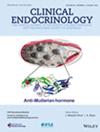Trabecular bone score norms in Asian-Indians and associations with serum 25(OH)D and parathyroid hormone
Abstract
Objective
There is limited information on population-specific norms of trabecular-bone-score (TBS) and its associated factors. Here, we provide norms of TBS in Asian-Indians and its relationship with serum 25-hydroxyvitamin D [25(OH)D] and intact-parathyroid hormone (iPTH).
Participants and Measurements
TBS, bone-mineral-density (BMD), and vertebral-fractures (VFs) were assessed using dual-energy X-ray absorptiometry in 923 healthy Asian-Indians (aged 20–60 years). Serum 25(OH)D, iPTH, T4/TSH,, glycosylated-haemoglobin (HbA1c) were measured and associations with TBS assessed using multivariable linear regression. Subjects with BMD Z-score ≤ −2.0 or ≥2.0 at any sites, VFs, TSH > 10.0 or <0.05 µIU/ml, blood-glucose >11.1 mmol/L or HbA1c > 8.0% were excluded for generating Asian-Indian norms.
Results
TBS norms were generated in 744 healthy Asian-Indians (M:F,389:385). The cut-offs generated for ‘normal’, ‘partially-degraded’, and ‘degraded’ TBS were >1.305, 1.204–1.305 and <1.204, respectively. Mean TBS was lower in females than males (p < .001). There was 75% congruency in TBS categories between Asian-Indian and existing norms. Specificity (97.8 vs. 77.9%, p < .001) and diagnostic-accuracy (97.8% vs. 78.4%, p < .001) of TBS to detect osteoporosis were higher with Asian-Indian norms. The sensitivity of ‘partially-degraded’ TBS to diagnose osteopenia was also higher with Asian-Indian norms. In multivariable regression, gender, body-mass-index (BMI), BMD-L1-L4, serum PTH, daily dietary-calorie intake and calcium intake were associated with TBS. Though 25(OH)D inversely correlated with PTH, 25(OH)D was not associated with TBS.
Conclusion
This study provides norms for TBS in Asian-Indians with gender-specific differences. Increasing age and higher BMI were associated with lower TBS. Associations of TBS with circulating PTH and/or 25(OH)D need confirmation in further studies.

 求助内容:
求助内容: 应助结果提醒方式:
应助结果提醒方式:


